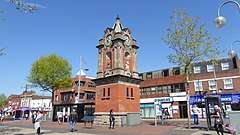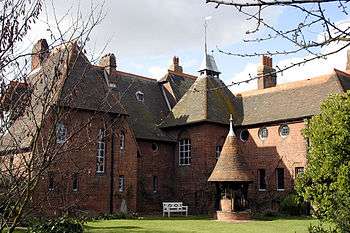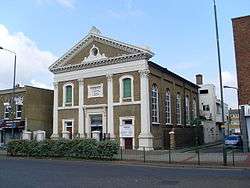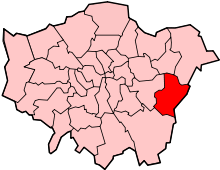Bexleyheath
Bexleyheath is a town in the London Borough of Bexley in Greater London, England with a population of 31,929. It is 12 miles (19.3 km) south-east of Charing Cross, and is identified in the London Plan as one of 35 major centres in Greater London.[2]
| Bexleyheath | |
|---|---|
 The Clocktower in Bexleyheath | |
 Bexleyheath Location within Greater London | |
| Population | 31,929 (2011 Census)[1] |
| OS grid reference | TQ485755 |
| • Charing Cross | 12 mi (19 km) WNW |
| London borough | |
| Ceremonial county | Greater London |
| Region | |
| Country | England |
| Sovereign state | United Kingdom |
| Post town | BEXLEYHEATH |
| Postcode district | DA6, DA7 |
| Dialling code | 020 01322 (eastern parts) |
| Police | Metropolitan |
| Fire | London |
| Ambulance | London |
| UK Parliament | |
| London Assembly | |
History

Until the early 19th century, Bexley Heath comprised an area of scrub-land with few buildings, although Bexley Heath windmill stood at the corner of what is today Erith Road and Mayplace Road. The heath bordered Watling Street. In 1766 Sir John Boyd had Danson House built in parkland (now Danson Park between Bexleyheath and Welling). In 1814 the land to the north of Bexley that would become Bexleyheath became subject to an Enclosure Act. In 1859 architect Philip Webb designed Red House for the artist, reforming designer and socialist William Morris on the western edge of the heath, in the hamlet of Upton—before Upton became largely developed as a London suburb. The National Trust acquired the house in 2003. Morris wanted to have a "Palace of Art" in which he and his friends could enjoy producing works of art. The house is of red brick with a steep tiled roof and an emphasis on natural materials. Red House is in a non-historical, brick-and-tile domestic style. It is now a Grade I listed building. Morris lived with his wife Jane in the house for five years, during which time their two daughters, Jenny and May, were born. Forced to sell the house for financial reasons in 1865, Morris vowed never to return to it—he said that to see the house again would be more than he could bear.
Bexleyheath's parish church, Christ Church, dates from 1841; and the parish of Bexleyheath from 1866; the building of the current church finished in 1877. Alfred Bean, railway-engineer and one-time owner of Danson House, furthered the development of Bexleyheath as a London suburb by championing the Bexleyheath Line in the 1880s to support the growth of estates around Danson Park. The clock-tower at the centre of the modern shopping area, built in 1912, commemorates the coronation of King George V.
Post war
Bexleyheath became the administrative base for the London Borough of Bexley upon its formation in 1965. The town centre shops and road layout were redeveloped in the 1980s and 1990s.
Geography
It is generally seen as being split into two parts by the old Roman road. The DA6 postcode area which is south Bexleyheath has a less homogeneous feel and features Danson House and the Red House. Adjacent to the park, Danson Road has an array of large houses, including a small number of Modernist buildings. In the north DA7 postcode area the majority of houses are predominantly 1930s semi-detached residences, apart from bungalows situated close to the railway station. This area includes part of the Bostall Park Estate, built by the developers Feakes & Richards.
Town centre

The modern town area is dominated by The Broadway Shopping Centre, a covered shopping centre completed in 1984, and an Asda supermarket (opened 28 November 1988), similar to facilities in other suburban towns and post-war 'New Towns'. A face-lift in 2008 on "The Mall" gave the centre a more modern internal appearance; externally it was largely unchanged. Other developments included the building of "Bexleyheath Square" in the early 2000s as an extension to the then "Broadway", providing more retail units. The 1990s saw the pedestrianisation of the road adjacent to "The Broadway" shopping centre (also known as the Broadway) following the construction of two minor bypasses (Arnsburg Way and Albion Way). Many of the changes to the town centre since 2000 have been in some way a response to competition from Bluewater Shopping Centre, 9 miles to the east in Greenhithe, Kent. Management was taken over in 2010 by Broadway Shopping Centre.
The statue outside the Broadway Centre is "Family Outing" by local artist John Ravera; it was commissioned by Norwich Union and unveiled in 1985.[3]
In May 2009 a major redevelopment scheme was approved by the local council following public consultation. This involved the redevelopment of sites occupied by the Bexley council buildings. The magistrates' court was to move to a new building on a site occupied by the library, which would be incorporated into the new development alongside 300 new homes. However, this development did not proceed following the sale of the Broadway Shopping Centre to new owners.
In 2012, the local council approved plans to establish its new Civic Offices in the former headquarters of The Woolwich, which had been vacant since 2005.[4] The existing civic offices were going to become a Tesco supermarket (previously Tesco had acquired the Woolwich HQ site). In June 2018, housebuilder Bellway received planning permission to build 518 homes, including 110 affordable ones, on the former civic office site. The development will include Bexleyheath's tallest building (13 storeys), public realm improvements and new commercial floorspace.[5]
With the expansion in retail space, Bexleyheath has drawn many customers from elsewhere in the borough, particularly from Erith and Thamesmead which have expanded in size with development along the River Thames, as well as from Plumstead and Woolwich in the neighbouring borough of Greenwich.
Leisure and culture
Bexleyheath has leisure facilities including the Edward Alderton Theatre, Cineworld cinema, hotel, reference library, five-a-side football centre, bingo hall and ten-pin bowling alley (Ten Pin).
Bexleyheath and Belvedere Hockey Club are based in Welling, but play some home matches at Erith School.[6]
Cultural events include regular concerts by the Sidcup Symphony Orchestra held in the hall of Townley Grammar School, while the Edward Alderton Theatre produces a number of non-professional productions each year. The theatre, which was founded in 1976, has a raked auditorium seating 74 and a proscenium stage.
Education
There are four secondary schools in Bexleyheath, namely Bexleyheath Academy, St Catherine's Catholic School for Girls, St Columba's Catholic Boys' School and Townley Grammar School.
Places of worship

- Bethany Hall, Chapel Road, Bexleyheath
- Bexleyheath Community Church, Lyndhurst Chapel, Lyndhurst Road, Barnehurst, DA7 6DL
- Bexleyheath United Reformed Church, Geddes Place
- Christ Church (Church of England), Broadway
- Bexleyheath Methodist Church, Broadway
- Trinity Baptist Church, Broadway
- St John Vianney Roman Catholic Church, Heathfield Road
- St Peters (Church of England), Pickford Lane
- St Thomas More Roman Catholic Church, Long Lane
- The Salvation Army, Lion Road
- Bexley Christian Life Centre (Pentecostal), Rowan Road
- Pantiles Methodist Church, Hurlingham Road
- Grace Baptist Church, Albion Road
- Christ Apostolic Church, Welling (CAC) Dove House
- Kingdom Hall of Jehovah's Witnesses, Upland Road
Transport
Rail
The town is served by Bexleyheath railway station, situated a couple of hundred metres to the north of the Broadway on Station Road. The station is on the Bexleyheath Line, the middle of three lines connecting London and Dartford. Rail services connect the station to London Victoria via Peckham Rye, London Charing Cross, London Cannon Street, Barnehurst, Gravesend and Dartford.
Buses
Bexleyheath is an important hub for Transport for London bus services. There are services connecting it with Bromley, Crayford, Dartford, Eltham, Erith, Lewisham, North Greenwich, Orpington, Sidcup, Thamesmead, Welling and Woolwich.
Notable residents
- Marjory Allen, Lady Allen of Hurtwood (1897-1976), landscape architect and child welfare campaigner[7]
- Harry Baker (1990-), footballer, born in Bexleyheath[8]
- Stephanie Brind (1977-), professional squash player, born in Bexleyheath and lived on Chieveley Road[9]
- Jimmy Bullard (1978-), Premiership football player[10]
- Kate Bush (1958-), singer-songwriter, born in Bexleyheath[11]
- Hall Caine (1853-1931), author, lived in Aberleigh Lodge, Bexleyheath from 1884 to 1889 next door to Red House.[12][13] Aberleigh Lodge was demolished in the 1970s.[14]
- David Daniels (1942-), cricketer, born in Bexleyheath[15]
- Bernie Ecclestone (1930-), Formula 1 magnate,[16][17] grew up in Danson Road[18]
- Frank Farmer (1912-2004), physicist, pioneer in developing medical applications for physics, born in Bexleyheath[19]
- Colin Gill (1892-1940), artist, born in Bexleyheath[20]
- Jake Goodman (1993-), footballer, lives in Bexleyheath[21]
- Sheila Hancock (1933-), actress, lived in Latham Road[22]
- David Haye (1980-), former WBA world heavyweight champion
- Neal Lawson (1963-), politician and commentator, grew up and went to school in Bexleyheath[23]
- Lenny McLean (1949–98), actor, bouncer, bare-knuckle boxer and 'hardest man in Britain', lived in Bexleyheath in later life[24]
- Jo Malone (1963-), perfumer and businesswoman.[25]
- Roger Moore (1927-2017) and Dorothy Squires (1915–98) lived in The Mount, Bexleyheath[26]
- William Morris (1834–96) lived in Red House for much of his life, when Bexleyheath was mostly countryside[27]
- Melita Norwood (1912-2005), Cold War Soviet spy[28]
- Kenneth Noye (1947-), gangster and convicted murderer, born on Lavernock Road[29]
- Tom Raworth (1938-2017), poet and visual artist, born in Bexleyheath and grew up in Welling[30]
- Liam Ridgewell (1984-), Portland Timbers footballer, born in Bexleyheath, attended Bexleyheath School[31]
- Delia Smith (1941-), television-chef, grew up in Bexleyheath, attended Bexleyheath School[32][33]
- Eric Stephenson (1914–44), footballer (Leeds United), born in Bexleyheath[34]
- Andy Townsend (1963-), professional footballer, grew up in Bexleyheath, attended Bexleyheath School[35]
- Charles Tupper (1821-1915), Canada's sixth Prime Minister lived his retirement years in Bexleyheath[36]
- Ian Williams (1967-), Olympic fencer, 1992 Summer Olympics, born in Bexleyheath
References
- Bexleyheath is made up of 3 wards in the London Borough of Bexley: Barnehurst, Brampton, and Christchurch. "Archived copy". Archived from the original on 22 February 2014. Retrieved 9 June 2014.CS1 maint: archived copy as title (link)
- Mayor of London (February 2008). "London Plan (Consolidated with Alterations since 2004)" (PDF). Greater London Authority. Archived from the original (PDF) on 2 June 2010.
- Public Monument and Sculpture Association National Recording Project, http://pmsa.cch.kcl.ac.uk/UEL/BE013.htm%5B%5D (Accessed: 28 November 2011)
- Fowler, Joshua. "Redevelopment of former Woolwich building in Bexleyheath approved". Bexley Times, 17 July 2012. Retrieved 5 September 2012.
- Morby, Aaron (27 June 2018). "Bexleyheath's 518-home town centre scheme approved". Construction Enquirer. Retrieved 27 June 2018.
- "BBHC Hockey Club". Archived from the original on 31 October 2012. Retrieved 16 March 2013.
- "Allen, Marjory Gill (1897-1976)". Birth Control International. Archived from the original on 24 November 2016. Retrieved 23 November 2016.
- "Profile for Harry Baker". doverathletic.com. Retrieved 23 November 2016.
- "Stunning Steph". Southern Daily Echo. Newsquest. 19 December 2000. Retrieved 18 January 2009.
- "Jimmy Bullard - back to my roots". clubwebsite.co.uk. Archived from the original on 14 November 2016. Retrieved 13 November 2016.
- Flynn, Julia (30 October 2014). "Kate Bush's London house is for sale". The Daily Telegraph. Retrieved 13 November 2016.
- "Surnames beginning with C". bexley.gov.uk. Archived from the original on 27 November 2016. Retrieved 26 November 2016.
- "The Globe". 23 November 1889. p. 6.
- Allen, Vivien (1 July 1997). Hall Caine: Portrait of a Victorian Romancer. A&C Black. p. 172. Retrieved 26 November 2016.
- "David Daniels". ESPN Cricinfo. Retrieved 19 August 2017.
- Poor Suffolk boy to Formula One billionaire Archived 10 November 2013 at the Wayback Machine, Eastern Daily Press, 3 March 2011. Retrieved 16 May 2011.
- Henry, Alan (10 December 2004). "The Guardian profile: Bernie Ecclestone". The Guardian. Retrieved 13 November 2016.
- May, Luke (27 January 2017). "From Danson Road to Abu Dhabi - Bexleyheath's Bernie Ecclestone sells-off Formula One for £6billion - find out about his local links HERE". Bexley Times. Archant Community Media Ltd. Retrieved 27 December 2017.
- Haggith, John (27 August 2004). "Obituary: Frank Farmer". Retrieved 23 November 2016.
- "Colin Gill (1892-1940) - British artist". Fascinating Facts of the Great War. Retrieved 23 November 2016.
- Cawley, Richard (13 November 2016). "Jake Goodman: FA Cup tie gives me another chance at achieving Den dream". London News Online. Archived from the original on 5 March 2017. Retrieved 23 November 2016.
- "Surnames beginning with H". bexley.gov.uk. Archived from the original on 14 November 2016. Retrieved 13 November 2016.
- "Neal Lawson". morebooks.de. Retrieved 13 November 2016.
- Marks, Kathy (6 August 1998). "East End send-off for a 'diamond geezer'". The Independent. Retrieved 13 November 2016.
- "Malone biography". Retrieved 22 November 2015.
- Ogley, Bob (6 March 2013). "Singer Dorothy Squires' turbulent life: Her marriage to Roger Moore and fire at Bexley home". Retrieved 13 November 2016.
- "Surnames beginning with M". bexley.gov.uk. Archived from the original on 14 November 2016. Retrieved 13 November 2016.
- John Cunningham (28 June 2005). "Melita Norwood ... Seemingly innocuous south London clerk..." The Guardian. Retrieved 1 June 2015.
- Thompson, Tony (16 April 2000). "Noye linked to more killings". The Guardian. London.
- Krueger, Christine L. (1 July 2014). Encyclopaedia of British Writers, 19th and 20th centuries. Infobase Publishing. p. 312. Retrieved 13 November 2016.
- Bacon, Jake (4 December 2015). "Bexleyheath mum to cheer on son Liam Ridgewell in America's biggest football match - the MLS cup final". News Shopper. Retrieved 13 November 2016.
- Lezard, Nicholas (11 December 1999). "Profile Delia Smith: Simmer gently, do not boil". The Independent. Retrieved 13 November 2016.
- "Delia Smith: Television cook and food writer". cooksinfo.com. Retrieved 13 November 2016.
- "Player profile". Oz White LUFC. Archived from the original on 16 August 2012. Retrieved 15 November 2010.
- "Surnames beginning with T". bexley.gov.uk. Archived from the original on 14 November 2016. Retrieved 13 November 2016.
- Buckner, Phillip (1998). "TUPPER, Sir CHARLES". In Cook, Ramsay; Hamelin, Jean (eds.). Dictionary of Canadian Biography. XIV (1911–1920) (online ed.). University of Toronto Press. Retrieved 17 September 2015.
